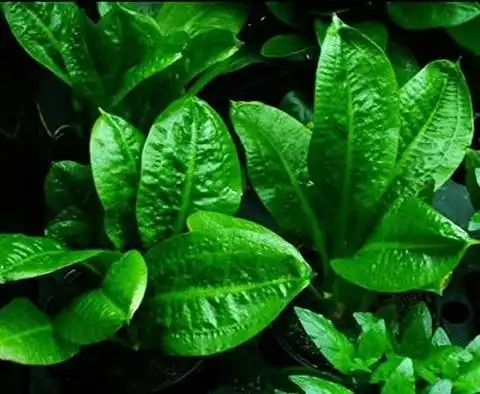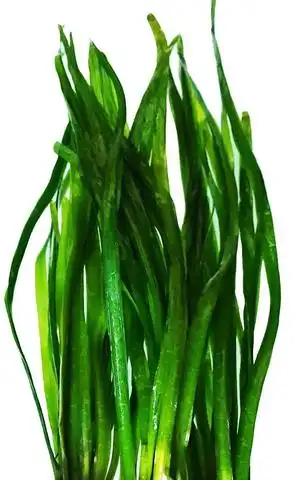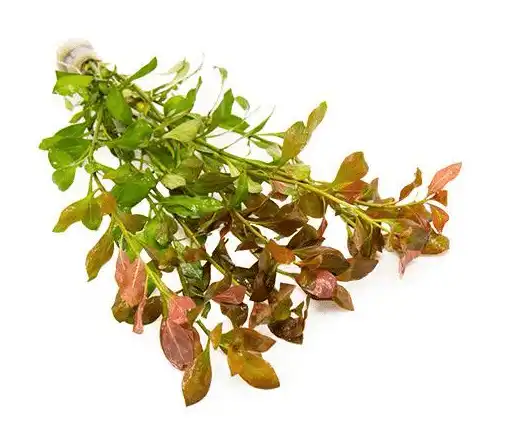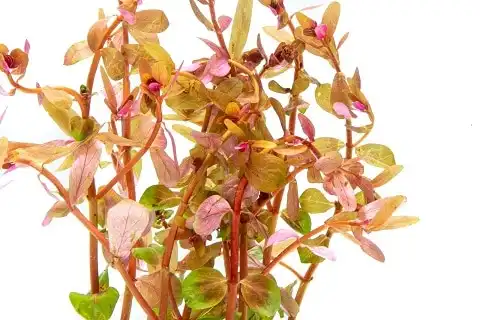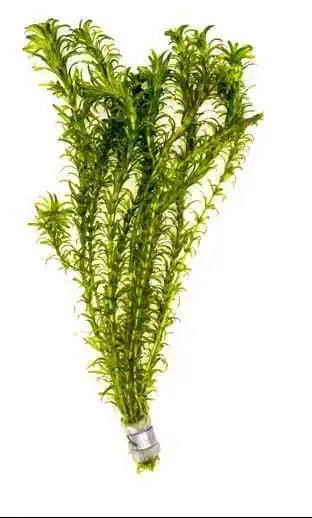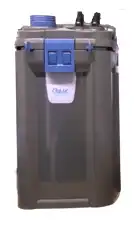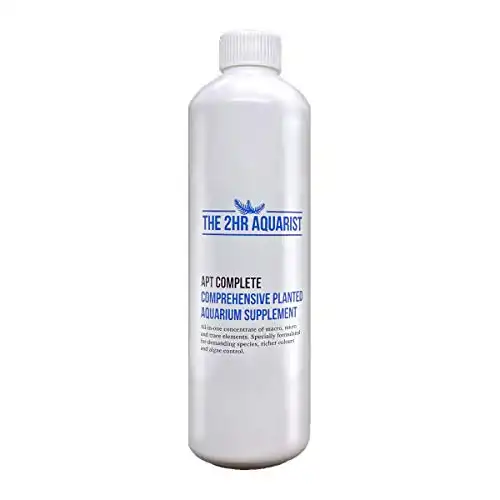Thank you for visiting! By the way… any links on this page that lead to products on Amazon and other stores/partners are affiliate links Aquarium Store Depot earns a commission if you make a purchase.
Are you setting up a planted aquarium? Growing a wall of vibrant live plants can add depth and movement to your aquascape, but which plants should you choose?
This article introduces 15 amazing tall aquarium plants for the background of your tank. Read along to learn more about each species and how to grow and care for them.
Let’s get started!
Key Takeaways
- Background plants are best in the back of your aquarium
- They typically represent stem plants, which have a fast growth rate and require lots of pruning
- Hornwort, Water Sprite, and Anacharis are some fo the easiest background plants to care for
The Benefits For Your Tank
Live aquarium plants have so many great benefits that it’s tough to know where to start! Aquatic plants are an important part of most freshwater ecosystems, so they make your fish feel right at home. Your fish will love exploring and hiding in tall aquarium plants, and some species will even lay their eggs in them!
Living plants take in carbon dioxide and breathe out oxygen, which is what your fish need to stay active and healthy. Plants also soak up excess nutrients in the water, which would otherwise cause water quality issues and even excessive algae growth.
Aquascaping
Plants benefit our tank environment in many ways that we can’t see, but there are also obvious aesthetic benefits to growing live aquarium plants!
A simple but effective aquascape concept for planted tanks is to plant tall aquarium plants (background plants) at the back of the tank, medium-sized plants in the middle, and low-growing plants in the front.
Tall plants at the back of the tank can also be used to cover up hardware like filters and heaters in the tank, and cables and other stuff behind your aquarium.
Best Aquarium Background Plants
Now that you know what background plants are, you’re probably wondering how to choose the best species for your tank!
You can use more than one individual plant species in the background, or use a single type. Whichever route you choose to go, it’s important to choose background plants that have suitable care needs and that grow to the right size.
We have a video below from our YouTube channel. We go into more detail in our blog post below. If you like our content, be sure to subscribe. We post new videos every week!
I’ve included the following important information for each species so you can be sure you’re picking the right plants:
- Scientific Name
- Skill Level
- Size
- Lighting
- pH
- Growth Rate
- CO2 Requirement
Now let’s get started!
1. Amazon Sword
A classic background aquarium plant. Grows large and will be a centerpiece in your aquarium
- Scientific Name: Echinodorus bleheri
- Skill Level: Easy
- Size: 4-20 inches
- Lighting: Moderate
- pH: 6.5- 7.5
- Growth Rate: Fast
- CO2 Requirement: No, recommended
The Amazon sword is a classic aquarium plant, and the perfect species to start our list! This large rosette plant is great for beginners because it does well under moderate light and does not need injected CO2 to thrive.
The Amazon sword plant has large, bright green leaves. They can be used to create a green wall of lush growth at the back of a medium to large aquarium.
2. Water Wisteria
An easy to grow and great beginner floating plant to try!
- Scientific Name: Hygrophila difformis
- Skill Level: Easy
- Size: 10 – 20 inches
- Lighting: Low-Moderate
- pH: 6-7.5
- Growth Rate: Fast
- CO2 Requirement: No
Water wisteria is a very easy background plant for planted aquariums. The leaves of this beautiful stem plant change shape as they grow larger. On young, emersed plants, the leaves are solid and broad, but on mature submerged plants, the leaves are finely textured and compound.
3. Moneywort

- Scientific Name: Bacopa monnieri
- Skill Level: Easy
- Size: 4- 12 inches
- Lighting: Moderate – high light
- pH: 6-7.5
- Growth Rate: Slow
- CO2 Requirement: No
Moneywort is a bright green stem plant that does great in the background of planted aquariums. This slow-growing plant is easy to care for and does not need increased CO2, although it does prefer a nutrient-rich substrate.
4. Ludwigia Natans Super Red
An amazing red aquarium plant that is easy to grow! A fast growing plant.
- Scientific Name: Ludwigia natans
- Skill Level: Easy
- Size: 6-20 inches
- Lighting: Moderate
- pH: 6-7
- Growth Rate: Fast
- CO2 Requirement: No
Ludwigia Natans Super Red is an excellent red aquarium background plant. This tall stem plant should be planted in clumps to create a dense background screen.
It is very easy to propagate by cuttings. Despite its name, this plant will be green if grown under lower lighting conditions.
5. Cryptocoryne Balansae
An easy to grow Crypt plant that does not grow fast. Unique textures make for a good background plant
- Scientific Name: Cryptocoryne crispatula var. balansae
- Skill Level: Moderate
- Size: 24-36 inches
- Lighting: Moderate-High light
- pH: 6.5 – 7.5
- Growth Rate: Moderate
- CO2 Requirement: Yes
Cryptocoryne balansae is a beautiful, long-leaved aquarium plant that can make an effective background species for your planted tank.
These tall aquarium plants do not grow as fast as some of the traditional stem plants but the texture and movement of their leaves make this plant an interesting focal point.
6. Vallisneria
One of the easiest background placement aquarium plants that can be kept. Provides excellent shelter for fish
- Scientific Name: Vallisneria americana, V. spiralis, etc.
- Skill Level: Moderate
- Size: 8-20 inches
- Lighting: moderate to high light
- pH: 6-7.5
- Growth Rate: Moderate-fast
- CO2 Requirement: Recommended
There are a few great varieties of Vallisneria in the aquarium hobby, and most of them make amazing background plants. These tall, grass-like plants show amazing movement in a tank with some flow.
Vals grow by sending out runners and rooting themselves into the substrate. When they are growing well, you’ll need to control their growth by cutting the shoot and replanting the new plant where you want it.
7. Ludwigia Repens
Buceplant offers both stem and tissue culture Ludwigia Repens at great prices. A great beginner red plant to try!
- Scientific Name: Ludwigia repens
- Skill Level: Easy
- Size: 4-8 inches
- Lighting: Moderate
- pH: 6-7
- Growth Rate: Fast
- CO2 Requirement: No
Ludwigia repens can make an amazing background plant for smaller aquariums. They are one of my favorite background plants because they can provide so much color without requiring too much care. This easy stem plant stays pretty low and has awesome red color if grown in good light.
8. Rotala Rotundifolia Red
An easy to grow stem plant with red colors. Easy to trim and propagate
- Scientific Name: Rotala rotundifolia
- Skill Level: Moderate
- Size: 4-8 inches
- Lighting: High light
- pH: 6.5-7.5
- Growth Rate: Fast
- CO2 Requirement: Yes
Rotala Rotundifolia red is the perfect choice for aquarists who want good color in the background. With good light, nutrients, and enough iron, this plant develops a brilliant red coloration.
This stem plant looks a little thin if planted in a single row so plant it in nice clumps for a dazzling display.
9. Egeria Densa (Anacharis)
Excellent as a food source and sucks up nutrients in an aquarium. One of the easiest freshwater plants to care for
- Scientific Name: Egeria densa
- Skill Level: Easy
- Size: 4 – 12 inches
- Lighting: Low – Moderate
- pH: 6.5-7.5
- Growth Rate: Moderate
- CO2 Requirement: No
Egeria densa is a great beginner plant for the background. It has a moderate growth rate and is very easy to propagate from stem cuttings. This dense leafy stem plant does not need bright light or CO2 to thrive and is an ideal choice for a cold water aquarium.
10. Cryptocoryne Retrospiralis
Another Crypt plant that works great as a background plant. Has a moderate growth rate compared to stem plants
- Scientific Name: Cryptocoryne retrospiralis
- Skill Level: Easy
- Size: 10-24 inches
- Lighting: Moderate
- pH: 6.5-7.5
- Growth Rate: Moderate
- CO2 Requirement: No
The best features of Cryptocoryne Retrospiralis are its awesome wavy leaf texture and subtle bronzy colors. This tall aquarium plant has a moderate growth rate so it does not require frequent trimming and maintenance.
11. Alternanthera Rosanervig
A taller red plant that is great for larger aquariums. A moderately difficult plant to keep
- Scientific Name: Alternanthera reineckii
- Skill Level: Moderate
- Size: 4-12 inches
- Lighting: Moderate – high light
- pH: 6.5 – 7.5
- Growth Rate: Moderate – fast
- CO2 Requirement: Yes
Alternanthera Rosanervig, or just AR, is one of the most colorful and vibrant background plants for freshwater aquariums. Its leaves are bright pink below and greenish above with pink veins and even its stems burst with color. For the best display, AR needs bright light and stable injected CO2.
12. Hornwort
A tall and easy to grow freshwater plant. One of the least demanding background plants available
- Scientific Name: Ceratophyllum demersum
- Skill Level: Easy
- Size: 6-15 inches
- Lighting: Moderate
- pH: 6.5-7.5
- Growth Rate: Moderate – fast
- CO2 Requirement: No
Hornwort is an easy, fast-growing plant that does not grow roots. It can make an effective background plant in tanks without substrate if you attach it to something like a rock or a plant weight.
13. Guppy Grass
Guppy Grass is a great plant for breeders and beginners. It is stress free, grows fast, and helps remove nutrients in an aquarium
- Scientific Name: Najas indica
- Skill Level: Easy
- Size: 4-12 inches
- Lighting: Low-moderate
- pH: 6-7.5
- Growth Rate: Fast
- CO2 Requirement: No
Guppy grass is another extremely easy plant to grow. This hardy plant can be grown as a stem plant by securing it in the substrate or you can simply leave it to float in the aquarium. It is a very fast-growing plant under good conditions.
14. African Water Fern
A plant that can be grown emersed or submerged. Easy to care for and does not require CO2
- Scientific Name: Bolbitis heudelotii
- Skill Level: Easy
- Size: 6 – 16 inches
- Lighting: Low
- pH: 6-7.5
- Growth Rate: Slow
- CO2 Requirement: No
The African water fern is an excellent choice for the background of tanks without substrate. It is an epiphyte which means it should not be planted but rather attached to hardscape features like rocks or driftwood.
15. Water Sprite
Readily available and easy to grow. This fast growing plant will soak up nutrients and thrive in low light
- Scientific Name: Ceratopteris thalictroides
- Skill Level: Easy
- Size: 6 – 15 inches
- Lighting: Moderate
- pH: 6-7.5
- Growth Rate: Fast
- CO2 Requirement: Yes, recommended
Water sprite is a tall, fast-growing stem plant that is great for beginners. This beautiful green plant is very easy to care for and can grow pretty tall, so it is best for the background of medium to large aquariums.
16. Lucky Bamboo
- Scientific Name: Dracaena sanderiana
- Skill Level: Easy
- Size: Up to 39 inches
- Lighting: Low
- pH: 6.0 – 7.5
- Growth Rate: Slow to Moderate
- CO2 Requirement: Optional
Lucky bamboo is a lesser known background plant but has been made more popular by recent tiktok videos. These plants can make a great background section in your aquarium for your fish to swim in and out of. They are hardy and easy to care for. Just make sure that you keep the leaves above water.
Tank Setup
Creating a beautiful planted tank can be simple if you start out in the right way. Here’s what you’ll need:
Lighting
All background aquarium plants need light to grow, but some plants need more light than others. As a general rule, plants develop the best colors and a denser growth form under bright lighting.
Most of the plants in this article will grow well under moderate lighting conditions and it is better to provide medium light if you do not have injected CO2. Whichever light strength you choose, make sure you use a full spectrum light that is specifically designed for growing aquarium plants.
Substrate
The substrate is the layer of gravel or sand at the bottom of a fish tank. This layer can do two things for your plants. Firstly, the substrate provides an anchor point where your plants can attach themselves and grow from. The substrate also provides nutrients to the root zone of aquatic plants.
There are two basic categories of aquarium substrates:
Inert Substrates
Inert substrates do not provide your plants with nutrients. They provide your plant with a place to root and grow from, and they also create a more natural look in your aquarium. A gravel substrate is a great example of this type of growing medium.
Active Substrates
This type of growing medium is a nutrient-rich substrate that ensures healthy plant root growth. Use this type of substrate in heavily planted aquariums with loads of root-feeding plants. Not all aquarium plants need to take nutrients from the substrate, however, so avoid this type of soil if you are only growing column-feeding stem plants, epiphytes, or floating plants.
The Best Planted Tank Substrate
The world's standard in active substrates for planted tanks. Created by brand that founded modern aquascaping
CO2 Injection
The next plant requirement you need to consider is carbon dioxide (CO2). This gas is what plants breathe in. Carbon dioxide occurs all around us, and it is naturally dissolved in our aquariums at low levels.
These natural levels are enough to sustain many aquarium plants, but if you want to see the best results, you’re going to want to increase the concentration. Many amazing aquarium plants just won’t grow well without injecting carbon dioxide into your aquarium. So how do you increase your CO2 levels?
Pressurized carbon dioxide systems are available as kits, which is probably the easiest route to go. These awesome systems are designed to allow you complete control over the amount of CO2 you dissolve into the water.
Use Offer Code ASD10%Off
The highest end offering by CO2Art. This package includes everything you need to perform consistent and the highest quality CO2 injection in the industry!
Filtration & Water Quality
All aquariums need quality filtration, including planted tanks. This essential piece of aquarium hardware filters out visible particles and also plays a vital role in regulating your tank water chemistry.
Aquarium filters come in all shapes and sizes, and many types will work well in a planted aquarium with background plants. I recommend canister filters for planted display tanks because they hold a lot of filtration media and can be housed outside of your tank, so you won’t see too much unnatural equipment when gazing at your beautiful plants and fish.
The Pro's Choice
The top choice among professional aquascapers. German engineering and equipped with an intregrated heater.
How To Grow Them In Your Tank
Read this section to learn the basics of growing and caring for live plants in the background of your aquarium.
Planting & Spacing
Planting background plants in your fish tank is very easy. Most background plants must be grown submerged, which means you’ll need to have your tank set up with your substrate in place and at least partially filled with water before you plant them out.
Stem plants are usually sold in bunches. You’ll need to separate the stems before planting them into the substrate individually. These plants will look a little thin when spread out in a row across the background of your tank, but they are usually very easy to propagate, so with a little patience, you can fill up the background in a few months. A more natural-looking option is to buy a few bundles of stem plants and plant them in bunches.
Rosette plants like Amazon swords and crypts are usually sold individually in pots. These plants grow more slowly, so it is best to buy as many as you need. They should not be moved around after being planted in the substrate, so take the time to plan your layout carefully.
Fertilization
Plants need access to nutrients to stay healthy and grow. Some plants will thrive without any added fertilizer because they get enough nutrients from fish waste, but if you plan on growing healthy background plants in a beautiful planted tank, regular dosing with a quality aquarium fertilizer is usually the way to go.
Editor's Choice
Made by an aquascaper for aquascapers. This is the best all around aquarium plant fertilizer on the market. Marco and micronutrients in one bottle!
Use Coupon Code ASDComplete for 10% off your order!
Different plants access nutrients in different ways. Root feeding plants, like Amazon sword, get most of their nutrients from the substrate. An active aquarium soil will provide them with most of what they need to grow. These plants can also be grown in inert substrates but will need to be fed with root tabs to sustain their growth in the long run.
Many stem plants like hornwort access nutrients that are dissolved in the water column and do not need a nutrient-rich substrate. These plants are known as column feeders and they will require regular doses of liquid fertilizer to grow their best.
Trimming
Most stem plants are fast growing under good conditions and will need regular pruning and trimming to stay neat and tidy. A good-quality pair of stainless aquascaping scissors will make this job much easier and more fun.
You’ll need to collect all the little bits of plant that you have cut and remove them from your tank before they begin to rot (video source). The best way to do this is to use a small aquarium net with fine mesh, but you can also siphon them out with a hose or your gravel vacuum.
Tank Maintenance
Growing live aquarium plants can have amazing benefits for water quality, but with poor maintenance, the opposite can also be true.
Melting plants and trimmings left to spoil in your water can even create toxic conditions for your fish. It’s important to remove all your plant trimming and any melting/dying growth as soon as possible.
As with any aquarium, a regular maintenance schedule will keep your tank healthy and looking beautiful in the long run. Use your aquarium test kit to keep an eye on your parameters.
Regular partial water changes will reset the nutrient levels in your tank and keep your water safe for your fish and plants.
Pests & Other Problems
Most of the popular freshwater fish can be kept in planted tanks without any problems, but some species are notorious for destroying live aquarium plants. These are some of the fish that you should avoid:
- Goldfish
- Silver dollars
- Buenos Aires Tetras
- African cichlids
Algae growth is the most common problem in planted tanks. Solving algae outbreaks can be tough, but you’ll almost always be able to succeed by making a few changes to the following:
- Tank maintenance schedule
- Lighting
- Carbon dioxide levels
- Fertilizer use
- Plant numbers
- Water temperatures
Where To Buy Them
Many of the background plants in this article can be found at your local fish store. Another great way to buy your plants is to order them online from trusted experts in the field. Where it is rare to find tissue culture plants when it comes to backgrounds plants, if you can find them buy them as they are pest free.
Buce Plant offers a wide variety of aquatic plants for sale. With one of the largest selections in the US, you will find what you need here. They are also a great source for freshwater shrimp!
FAQs
Which background is good for planted aquarium?
A healthy wall of living plants is my favorite kind of fish tank background, although you can use solid black, white, or even backlight backgrounds while your plants grow in.
What is a background plant?
A background plant is usually a tall plant that is used to cover the back wall of the aquarium. These are mostly stem plants, although tall, long-leaved rosette plants can also make a great choice.
How big do aquarium plants get?
Each different species of aquarium plant can grow to a different size. They range in size from foreground plants that reach an inch or less to tall species that can grow to several feet. Their ultimate size also depends on their growing conditions, however. Expect your plants to grow larger and healthier with good light, injected carbon dioxide, and regular doses of fertilizer.
Do Bettas need tall plants?
Betta fish love planted aquariums. They will benefit from just about any kind of aquarium plant, although they definitely enjoy hanging out in taller plants with large leaves.
What is the fastest-growing aquarium plant?
Hornwort is one of the fastest-growing aquarium plants in the hobby. This species can make a great background, but it will require regular trimming and maintenance to keep it under control.
Final Thoughts
Aquarists have long known that live plants can be used to create a beautiful and healthy aquarium. Deciding which plants to grow can be tough, but the 15 species highlighted in this guide are all amazing options. If you haven’t started growing live plants in your fish tank, why not start today?
Do you grow live plants in the background of your fish tank? Tell us about your favorite plants in the comments below!
- About the Author
- Latest Posts
I’m thrilled that you found Aquarium Store Depot! Here you’ll find information on fish, aquariums, and all things aquatics related. I’m a hobbyist (being doing this since I was 11) and here to help other hobbyists thrive with their aquariums! I adhere to a high quality Editorial Process and Review products with real life field usage and practical analysis.


